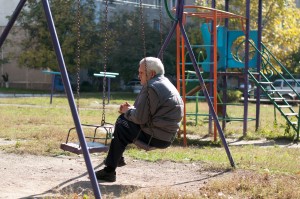
By B. Rose Huber, Woodrow Wilson School of Public and International Affairs
A new study from Princeton University shows that health assessments made by medically untrained interviewers may predict the mortality of individuals better than those made by physicians or the individuals themselves.
Features like forehead wrinkles and lack of agility may reflect a person’s overall health and risk of dying, according to recent health research. But do physicians consider such details when assessing patients’ overall health and functioning?
In a survey of approximately 1,200 Taiwanese participants, Princeton University researchers found that interviewers — who were not health professionals but were trained to administer the survey — provided health assessments that were related to a survey participant’s risk of dying, in part because they were attuned to facial expressions, responsiveness and overall agility.
The researchers report in the journal Epidemiology that these assessments were even more accurate predictors of dying than assessments made by physicians or even the individuals themselves. The findings show that survey interviewers, who typically spend a fair amount of time observing participants, can glean important information regarding participants’ health through thorough observations.
“Your face and body reveal a lot about your life. We speculate that a lot of information about a person’s health is reflected in their face, movements, speech and functioning, as well as in the information explicitly collected during interviews,” said Noreen Goldman, Hughes-Rogers Professor of Demography and Public Affairs in the Woodrow Wilson School.
Together with lead author of the paper, Princeton Ph.D. candidate Megan Todd, Goldman analyzed data collected by the Social Environment and Biomarkers of Aging Study (SEBAS). This study was designed by Goldman and co-investigator Maxine Weinstein at Georgetown University to evaluate the linkages among the social environment, stress and health. Beginning in 2000, SEBAS conducted extensive home interviews, collected biological specimens and administered medical examinations with middle-aged and older adults in Taiwan. Goldman and Todd used the 2006 wave of this study, which included both interviewer and physician assessments, for their analysis. They also included death registration data through 2011 to ascertain the survival status of those interviewed.
The survey used in the study included detailed questions regarding participants’ health conditions and social environment. Participants’ physical functioning was evaluated through tasks that determined, for example, their walking speed and grip strength. Health assessments were elicited from participants, interviewers and physicians on identical five-point scales by asking “Regarding your/the respondent’s current state of health, do you feel it is excellent (5), good (4), average (3), not so good (2) or poor (1)?”
Participants answered this question near the beginning of the interview, before other health questions were asked. Interviewers assessed the participants’ health at the end of the survey, after administering the questionnaire and evaluating participants’ performance on a set of tasks, such as walking a short distance and getting up and down from a chair. And physicians — who were hired by the study and were not the participants’ primary care physicians — provided their assessments after physical exams and reviews of the participants’ medical histories. (Study investigators did not provide special guidance about how to rate overall health to any group.)
In order to understand the many variables that go into predicting mortality, Goldman and Todd factored into their statistical models such socio-demographic variables as gender, place of residence, education, marital status, and participation in social activities. They also considered chronic conditions, psychological wellbeing (such as depressive symptoms) and physical functioning to account for a fuller picture of health.
“Mortality is easy to measure because we have death records indicating when a person has died,” Goldman said. “Overall health, on the other hand, is very complicated to measure but obviously very important for addressing health policy issues.”
Two unexpected results emerged from Goldman and Todd’s analysis. The first: physicians’ ratings proved to be weak predictors of survival. “The physicians performed a medical exam equivalent to an annual physical exam, plus an abdominal ultrasound; they have specialized knowledge regarding health conditions,” Goldman explained. “Given access to such information, we anticipated stronger, more accurate predictions of death,” she said. “These results call into question previous studies’ assumptions that physicians’ ‘objective health’ ratings are superior to ‘subjective’ ratings provided by the survey participants themselves.”
In a second surprising finding, the team found that interviewers’ ratings were considerably more powerful for predicting mortality than self-ratings. This is likely, Goldman said, because interviewers considered respondents’ movements, appearance and responsiveness in addition to the detailed health information gathered during the interviews. Also, Goldman posits, interviewer ratings are probably less affected by bias than self-reports.
“The ‘self-rated health’ question is religiously used by health researchers and social scientists, and, although it has been shown to predict mortality, it suffers from many biases. People use it because it’s easy and simple,” Goldman continued. “But the problem with self-rated health is that we have no idea what reference group the respondent is using when evaluating his or her own health. Different ethnic and racial groups respond differently as do varying socioeconomic groups. We need other simple ways to rate individual health instead of relying so heavily on self-rated health.”
One way, Goldman suggests, is by including interviewer ratings in surveys along with self-ratings: “This is a straightforward and cost-free addition to a questionnaire that is likely to improve our measurement of health in any population,” Goldman said.
The paper, “Do Interviewer and Physician Health Ratings Predict Mortality? A Comparison with Self-Rated Health,” first appeared online in Epidemology in August 2013. The article also will be featured in the November print edition. The research was conducted with the assistance of colleagues at Princeton’s Office of Population Research, Georgetown University and the Bureau of Health Promotion in the Taiwan Department of Health.
Todd MA, Goldman N. Do interviewer and physician health ratings predict mortality?: a comparison with self-rated health. Epidemiology. 2013 Nov;24(6):913-20. doi: 10.1097/EDE.0b013e3182a713a8.

You must be logged in to post a comment.